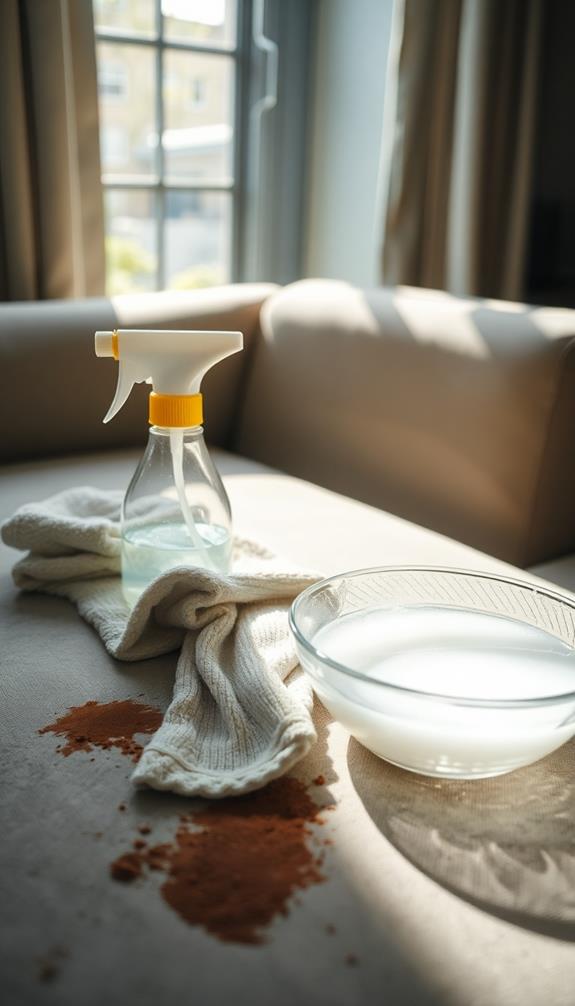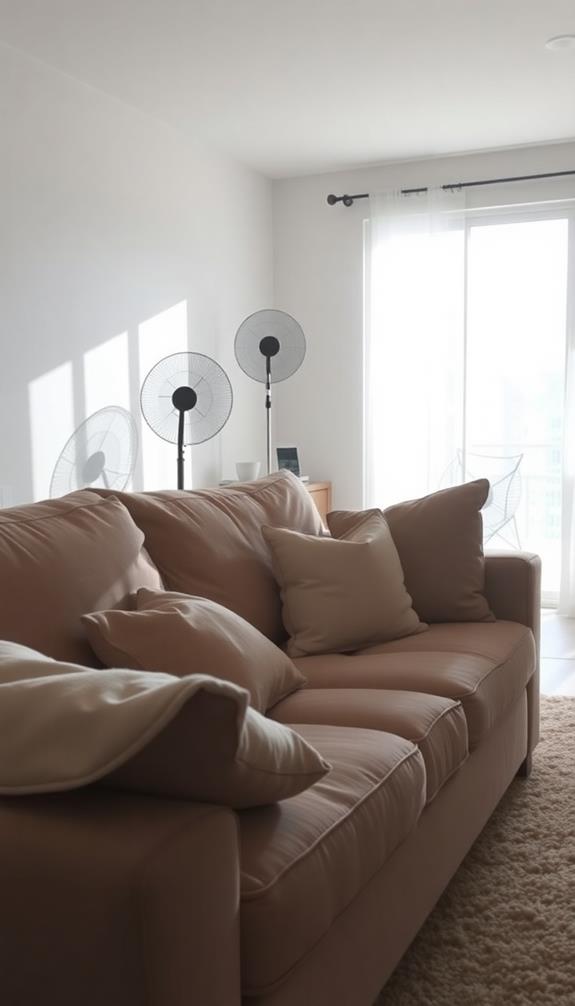To deep clean your couch, start by checking the upholstery care codes to know which cleaning method to use. Next, vacuum thoroughly with an upholstery attachment, focusing on seams and under cushions. Treat any stains with a suitable cleaner, testing it on a hidden area first. Freshen things up by sprinkling baking soda on the fabric, letting it sit for 15-30 minutes, then vacuuming it off. Finally, allow the couch to air dry completely to prevent mold and mildew. Follow these steps and you'll keep your couch looking its best while discovering even more cleaning tips ahead.
Check Upholstery Care Codes
Before diving into the deep cleaning process, it's vital to check your couch's upholstery care codes. These codes are significant symbols found on furniture tags that guide you in selecting the appropriate cleaning methods for different fabric types.
For example, if you see a "W," it means you can safely use water-based cleaners. On the other hand, an "S" indicates that only solvent-based cleaning products should be used to avoid any fabric damage.
If your couch has a "W/S" code, you're in luck! You can choose between both water- and solvent-based cleaners, giving you flexibility in your cleaning process.
However, if you see an "X," remember that only vacuuming or brushing is recommended. Using any cleaning products with this code can lead to serious fabric damage, like loose threads or discoloration.
Couch manufacturers provide these upholstery care codes for a reason, so be sure to follow them closely. By understanding these codes, you can effectively protect your investment and maintain the beauty of your couch's upholstery.
Always check before you clean to confirm you're using the right methods for your fabric type.
Vacuum Thoroughly
To achieve a truly clean couch, start by vacuuming thoroughly. Regular maintenance, including vacuuming upholstered chairs weekly, can streamline the cleaning process and help prevent dirt buildup.
Use an upholstery attachment on your vacuum cleaner to effectively remove dirt, pet hair, and allergens. Begin by vacuuming the entire couch, including under the removable cushions, to eliminate debris that may have accumulated over time.
Pay special attention to seams and corners where dust and crumbs tend to gather for a thorough cleaning.
Here are some key steps to follow:
- Remove all cushions to access hidden dirt.
- Use a handheld vacuum for quick removal of larger pet hair clumps.
- Focus on seams and edges where debris often hides.
- Vacuum at least once a week to maintain your couch's appearance.
- Consider using a crevice tool for those hard-to-reach areas.
Regular vacuuming helps prevent dirt build-up that can lead to stains, ensuring your couch remains in great condition.
Treat Stains Effectively

Stains can be one of the biggest challenges when it comes to keeping your couch looking fresh and inviting. To tackle them effectively, start by performing a spot treatment. Always test any cleaning solution on a hidden area of the couch fabric to avoid damage or discoloration.
For common stains, use enzyme-based stain removers or a mild dish soap solution, as these gentle cleaners help protect the fabric. Additionally, it's important to know the upholstery fabric cleaning codes to guarantee you're using the right method for your specific couch type, which can greatly enhance your cleaning results understanding fabric codes.
Apply the cleaning solution and let it sit for a few minutes before you blot the stain with a clean cloth.
If you have a microfiber couch, rubbing alcohol can be your best friend; just use a light-colored sponge to prevent color transfer. It's vital to address wet stains immediately—blot the stain gently instead of rubbing, which can spread the stain deeper into the upholstery.
Regularly treating stains as they happen will help prevent them from setting in, making deep cleaning much easier down the road. Remember, maintaining your couch's appearance is all about prompt action and the right cleaning methods. By following these steps, you can keep your couch looking as good as new!
Freshen With Baking Soda
A simple yet effective way to freshen up your couch is by using baking soda. This natural odor absorber works wonders, especially for fabric couches.
Start by thoroughly vacuuming the couch to remove surface dirt and debris. This step allows the baking soda to penetrate the fabric more effectively. Additionally, make certain to check the fabric care labels for any specific cleaning instructions to guarantee you're not damaging the material while cleaning, as cleaning codes can guide you.
After vacuuming, sprinkle a generous amount of baking soda over the entire couch and let it sit for at least 15-30 minutes. This gives it time to neutralize smells and absorb odors. For an enhanced cleaning experience, consider mixing in a few drops of essential oils for a pleasant fragrance.
Here's a quick guide to freshening your couch with baking soda:
- Thoroughly vacuum the couch to eliminate dirt.
- Sprinkle baking soda evenly over the fabric.
- Let it sit for 15-30 minutes to work its magic.
- Vacuum the couch again to remove the baking soda.
- Regularly repeat this process to prevent buildup of odors from pets, food, or spills.
Using baking soda not only refreshes your couch but also maintains its cleanliness over time.
Allow to Dry Completely

After cleaning your couch, it's vital to let it air dry completely. This step prevents moisture-related issues, such as mold and mildew growth, which can occur if the fabric remains damp.
To facilitate this process, use fans or open windows to improve airflow, especially in humid conditions. This extra ventilation can greatly reduce drying time. Additionally, understanding the specific cleaning methods for different fabric types can enhance the drying process and overall care of your upholstery, as noted in the best cleaning practices.
It's essential to resist the urge to place cushions back on the couch until the fabric is fully dry. Trapping moisture can lead to unpleasant odors and further complications.
Keep in mind that drying time varies depending on fabric type and humidity levels, so patience is key. You should wait at least several hours before using the couch again.
Regularly maintaining proper drying techniques not only guarantees your couch remains fresh but also contributes to its longevity and cleanliness.
Conclusion
Now that you've deep cleaned your couch, it's like a refreshing change has swept through your living room. With those upholstery care codes checked, stains treated, and baking soda working its magic, your couch is ready to welcome you back in style. Just let it dry completely, and you'll be sinking into a clean, inviting oasis. Enjoy your revitalized space, and remember, a little maintenance goes a long way in keeping it looking pristine!